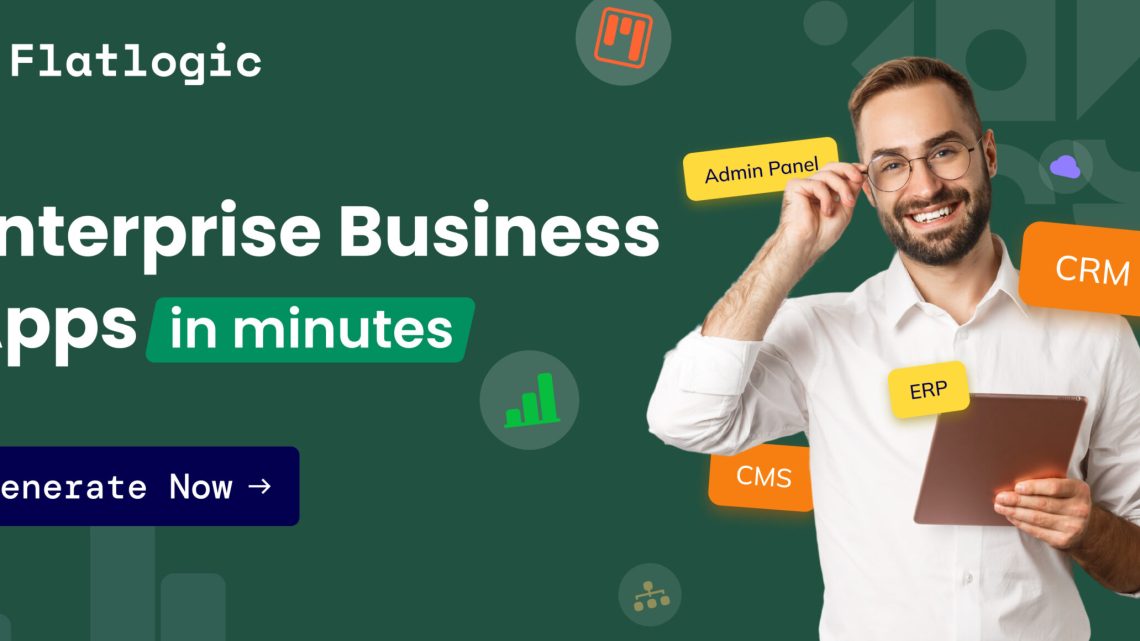
Best 10+ AI Tools For Data Analysis
April 8, 2024Drowning in data but starving for insights? This journey through the top AI tools for data analysis might just be your lifeline.
When embarking on the quest for the ultimate AI tool for data analysis, you’re likely bombarded with an avalanche of questions: Which AI tools for data analysis can truly decipher the cryptic language of data? How do they streamline the analysis process? Can they predict trends and offer actionable insights? In the wise words of Geoffrey Hinton, “AI is like a magic trick: once you know how it’s done, it’s not that impressive.” But finding that “how” is precisely what this article is about.
Researches show that AI tools analyzing data can quickly find patterns and make forecasts that humans wouldn’t spot quickly. This big jump is shaking up various fields, like healthcare and finance, faster than ever before.
With a background steeped in software engineering and a proven track record of deciphering the most cryptic datasets into clear, actionable strategies, the insights here are forged in the fires of real-world application. From leading teams that developed cutting-edge analytics platforms to advising top-tier firms on data strategy, this isn’t theory, it’s practice.
By reading this article, you will have more than just a list of AI tools for data analysis. You’ll have a blueprint for turning raw data into strategic gold. You’ll understand not only the “what,” but also the “why” and “how” of each tool, enabling you to not only pick the right weapon for your data battles but to wield it with precision. With this knowledge, you can effectively integrate these tools with your business software, enhancing your ability to make informed decisions and optimize your operations for peak performance.
| Tool Name | Pricing Model | Key Features |
| TensorFlow | Open-source (Free) | High-performance computation, deep learning support |
| PyTorch | Open-source (Free) | Dynamic computational graph, deep learning |
| Jupyter | Open-source (Free) | Supports live code, visualizations, and markdown |
| Azure ML | Pay-as-you-go | Automated ML, scalable lifecycle management |
| IBM Watson | Subscription-based | Advanced NLP, data visualization |
| Google Cloud AI | Pay-as-you-go | Supports multiple ML frameworks, scalable |
| DataRobot | Subscription-based | Automated machine learning (AutoML) |
| Tableau | Subscription-based | Intuitive data visualization tools, AI-driven analytics |
| RapidMiner | Free tier; Subscription for advanced features | Visual workflow designer, automated model validation |
| KNIME | Open-source (Free); Commercial licenses for additional features | Visual programming, workflow management |
Unlocking the Future: Why AI Tools for Data Analysis are Inevitable
This section delves into why harnessing AI for data interpretation isn’t just a futuristic fantasy—it’s an essential stride towards a data-driven tomorrow. Here, we unravel the core reasons for making AI tools for data analysis relevant and indispensable for anyone looking to thrive in the data-rich landscape of the future.
- Unmanageable Data Volumes. We’re producing data in volumes that are, quite frankly, beyond human capacity to process and analyze efficiently. AI tools for data analysis can handle this scale, making sense of data that would take humans lifetimes to analyze.
- Complexity Beyond Human Analysis. The complexity of data patterns and the insights they hold are often beyond the reach of traditional statistical methods or human analysis. AI tools for data analysis can detect, analyze, and learn from patterns at a level of complexity that’s necessary for today’s data-driven decisions.
- Speed of Processing. In a world where real-time decisions can make or break markets, AI tools for data analysis’s ability to process and analyze data at speeds no human team can match is not just an advantage, it’s a necessity.
- Predictive Power. The ability to predict future trends based on historical data is invaluable. AI tools for data analysis do this through advanced algorithms and machine learning, offering insights that can guide strategic planning and operational adjustments in real time.
- Error Reduction. AI tools for data analysis significantly reduce the margin for human error. It doesn’t tire, it doesn’t overlook, and it doesn’t misinterpret due to bias or fatigue, making it an essential tool for high-stakes data analysis.
- Accessibility and Democratization. AI tools are making high-level data analysis accessible to a broader range of businesses and organizations. This democratization means that even smaller entities can compete on the same playing field as larger corporations.
- Adaptability and Learning. Unlike static tools, AI systems learn and adapt over time. They become more efficient and accurate with more data, meaning they continually improve in their analysis and predictions.
Best 10+ AI Tools For Data Analysis in 2024
Navigating the vast ocean of AI tools for data analysis can feel like searching for treasure without a map. But fear not, intrepid explorer! We’ve charted the waters for you, compiling a list of the 10+ best AI tools that are transforming data analysis. From machine learning marvels to visualization virtuosos, these tools are the compasses and sextants that guide businesses and researchers alike through the data deluge. Whether you’re a seasoned data scientist or a business analyst looking to harness the power of AI, this guide will illuminate the path to insight and innovation.
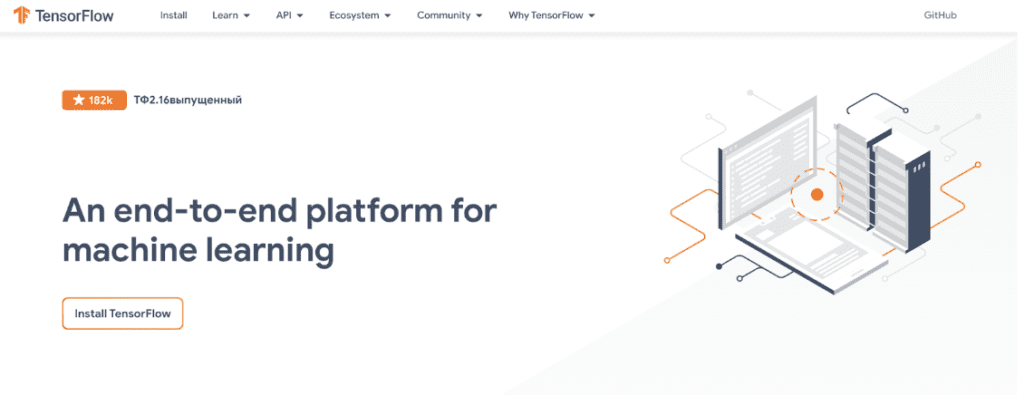
Developed by the brainiacs at Google, TensorFlow stands tall as a powerhouse for numerical computation and machine learning. This open-source library is beloved for its flexibility, allowing users to craft machine-learning models with a breeze. Whether you’re a startup dabbling in predictive analytics or a researcher pushing the boundaries of AI, TensorFlow’s robust framework supports both CPUs and GPUs for efficient computation.
Pricing Model: Open-source (Free)
Key Features:
- High-performance numerical computation
- Deep learning and neural network modeling
- Cross-platform (works on both CPUs and GPUs)
- Extensive community and resource library
Pros:
- Highly versatile and scalable
- Strong community support
- Integration with Google Cloud
Cons:
- The steep learning curve for beginners
- Can be resource-intensive
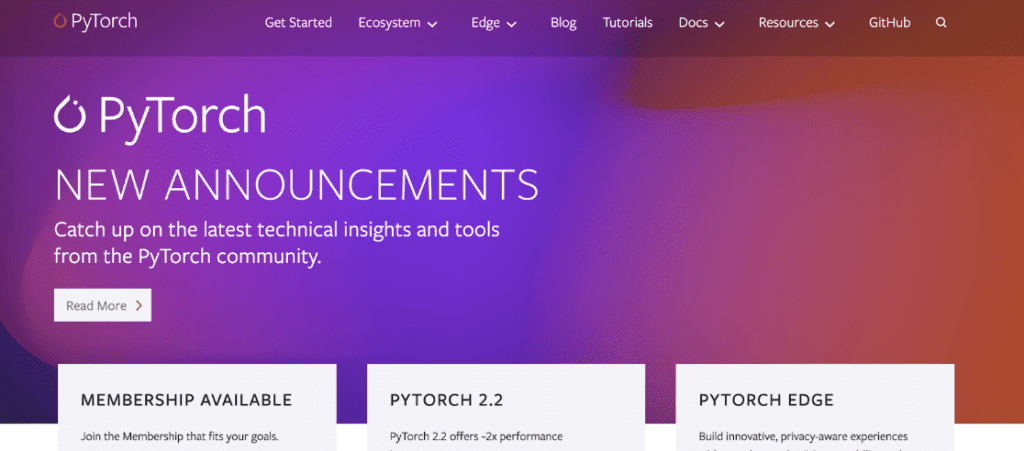
PyTorch is the torchbearer for researchers and developers aiming for the stars with their deep learning projects. Birthed by Facebook’s AI Research lab, this tool is intuitive, flexible, and power-packed for modeling and training deep learning algorithms. With its dynamic computational graph and thriving ecosystem, PyTorch facilitates the rapid prototyping of models, scaling from desktops to cloud-based services without breaking a sweat.
Pricing Model: Open-source (Free)
Key Features:
- Dynamic computational graph
- Strong support for deep learning
- Easy model prototyping and deployment
- Active and supportive community
Pros:
- Excellent for research and development
- User-friendly for Python developers
- Seamless integration with other AI frameworks
Cons:
- Documentation can be overwhelming
- Slightly fewer resources than TensorFlow
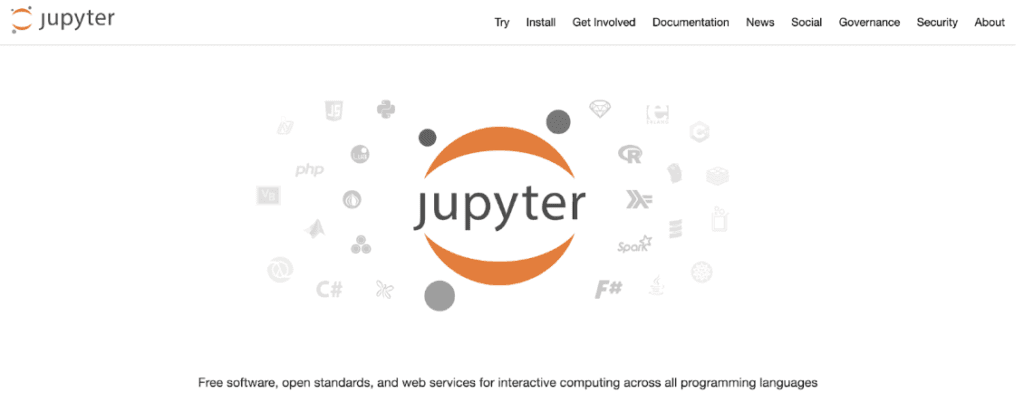
Jupyter Notebook is the digital canvas for data scientists who paint with code. This open-source tool allows for the creation and sharing of documents that contain live code, equations, visualizations, and narrative text. Ideal for data cleaning, transformation, numerical simulation, and statistical modeling, Jupyter supports over 40 programming languages, including Python, R, Julia, and Scala, making it a versatile tool for collaborative data analysis.
Pricing Model: Open-source (Free)
Key Features:
- Supports live code, visualizations, and markdown
- Compatible with numerous programming languages
- Integrates with big data tools and frameworks
Pros:
- Highly interactive and collaborative
- Supports reproducible research
- Extensive support for data visualization
Cons:
- Can become unwieldy for very large notebooks
- Security issues if not properly configured
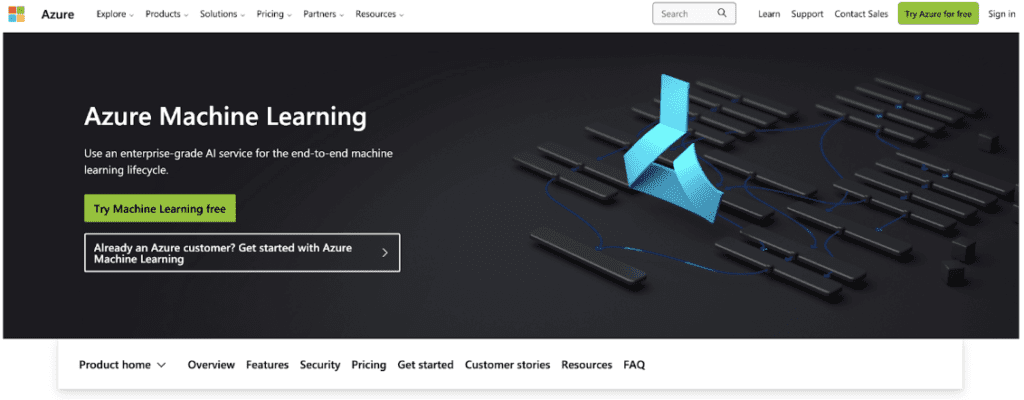
Microsoft’s Azure Machine Learning is a cloud-based beast for training, deploying, and managing machine learning models at scale. Offering a blend of pre-built AI capabilities and custom modeling, this platform empowers users to accelerate the end-to-end machine learning lifecycle. With its drag-and-drop interface and extensive toolset, Azure ML democratizes AI, making it accessible to both seasoned data scientists and beginners alike.
Pricing Model: Pay-as-you-go
Key Features:
- Automated machine learning
- Scalable end-to-end machine learning lifecycle management
- Integrated development environment
Pros:
- Highly scalable and flexible
- Strong security features
- Comprehensive toolset for all AI development stages
Cons:
- Pricing can be complex and potentially expensive
- Can be overwhelming for beginners
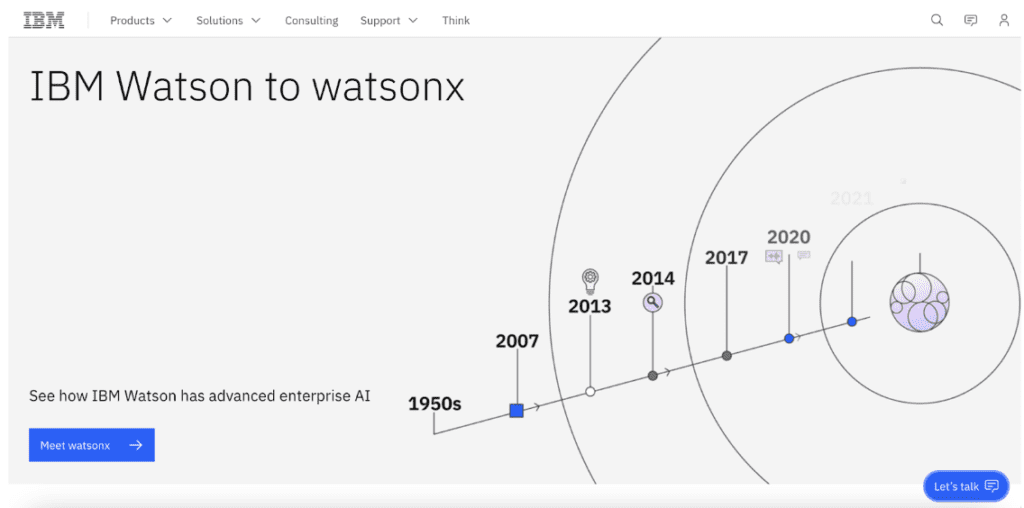
IBM Watson stands as a colossus in the realm of AI, offering a robust suite of AI tools and applications for businesses. From natural language processing to data visualization, Watson’s capabilities are designed to augment human intelligence, enhance decision-making, and drive innovation. Its API suite allows developers to integrate AI into their applications effortlessly, while its enterprise-grade security ensures data integrity and compliance.
Pricing Model: Subscription-based
Key Features:
- Advanced natural language processing
- Data visualization and analysis
- Secure and scalable AI integration
Pros:
- The broad range of AI capabilities
- Strong focus on enterprise solutions
- Extensive industry applications
Cons:
- Pricing can be steep for small businesses
- The complexity of tools requires a learning curve

The Google Cloud AI Platform is a comprehensive suite designed to bring AI deployment and development within reach of businesses of all sizes. With this platform, users can build, train, and deploy machine learning models on the highly scalable and reliable infrastructure of Google Cloud. The platform supports a wide range of machine learning frameworks, including TensorFlow, and offers both automated and custom model-building capabilities to suit various levels of expertise.
Pricing Model: Pay-as-you-go
Key Features:
- Support for multiple ML frameworks
- Automated and custom model capabilities
- Integration with Google Cloud services
Pros:
- High scalability and reliability
- Extensive AI and machine learning tools
- Seamless integration with other Google Cloud services
Cons:
- Can be costly for large-scale deployments
- May require a steep learning curve for beginners
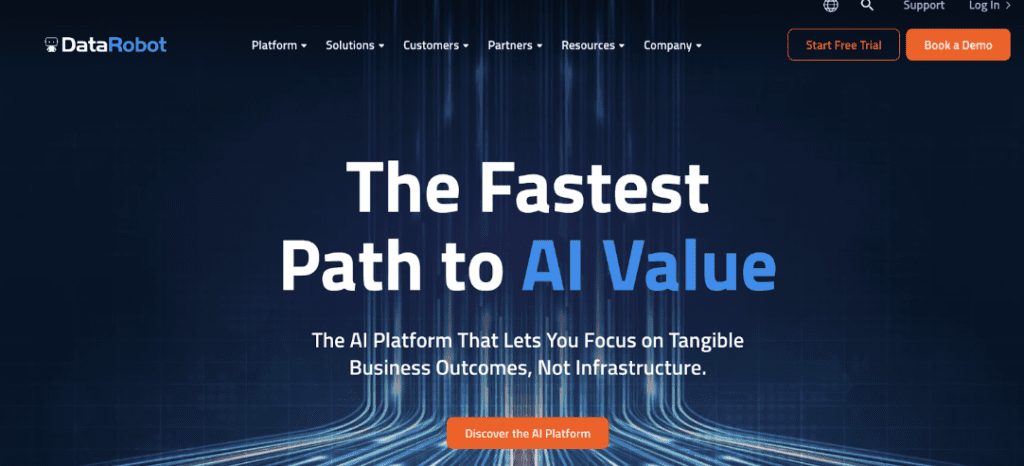
DataRobot offers an enterprise AI platform that automates the machine learning process to enable fast and easy deployment of predictive models. This platform is designed for data scientists, business analysts, and developers to build and deploy AI applications at scale. DataRobot’s claim to fame is its automated machine learning (AutoML) feature, which accelerates the creation of advanced predictive models.
Pricing Model: Subscription-based
Key Features:
- Automated machine learning (AutoML)
- Model deployment and monitoring
- Scalable AI application development
Pros:
- Streamlines the model-building process
- Supports a wide range of data types and sources
- Provides insights and model explanations
Cons:
- Pricing can be opaque and expensive
- May require initial training to navigate complex features

While not exclusively an AI tool, Tableau is a powerhouse in the world of data visualization and business intelligence. It helps users see and understand data, transforming the way people use data to solve problems. With its powerful analytical tools, Tableau enables users to make data-driven decisions with ease. It also incorporates AI-driven insights, offering explanations and predictions to augment its core functionalities.
Pricing Model: Subscription-based
Key Features:
- Intuitive data visualization tools
- AI-driven analytics and insights
- Integration with a wide array of data sources
Pros:
- User-friendly interface
- Powerful data visualization capabilities
- Robust data connectivity options
Cons:
- Can be expensive for small teams or individuals
- Advanced analytics features may have a learning curve
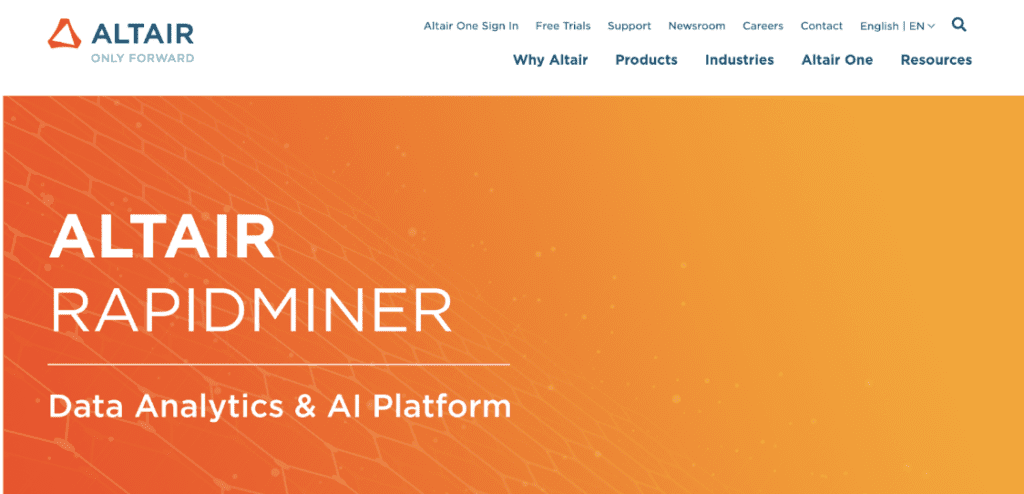
RapidMiner is an end-to-end data science platform that provides tools for data prep, machine learning, deep learning, text mining, and predictive analytics. It is designed to be accessible to all users, from data scientists to business analysts, allowing for the creation of predictive models without the need for extensive coding knowledge. RapidMiner stands out for its comprehensive platform that covers the entire data science lifecycle.
Pricing Model: Free tier available; subscription for advanced features
Key Features:
- Visual workflow designer
- Automated model validation
- Extensive data science toolset
Pros:
- Comprehensive platform for the data science lifecycle
- Accessible to users with varying levels of expertise
- Strong community support and resources
Cons:
- The full feature set can be costly
- May require time to learn and master the platform

KNIME is an open-source platform for data-driven innovation, helping users discover the potential hidden in their data, mine for fresh insights, or predict new futures. With nodes for various types of data transformation and analysis, KNIME is designed to be an intuitive, drag-and-drop interface that simplifies complex data workflows. It is particularly favored for its ability to blend traditional data sources with unstructured data.
Pricing Model: Open-source (Free); commercial licenses available for additional features
Key Features:
- Visual programming and workflow management
- Integration with machine learning and AI libraries
- Extensive range of data transformation and analysis nodes
Pros:
- Highly flexible and extensible
- No programming is required for basic tasks
- Strong support for a variety of data
Cons:
- The full feature set can be costly
Summing Up
In the rapid-fire world of data analytics, the evolution of AI tools has been a game-changer, offering unprecedented efficiency, accuracy, and insight. Our exploration has revealed the top 10 AI tools that stand out in the data analytics landscape, each with its unique strengths, from TensorFlow’s high-performance computation to Tableau’s intuitive data visualization. These tools are essential for anyone looking to navigate the vast seas of data and extract meaningful insights.
Navigating from data to decisions can be tricky, even with the best tech. That’s where Flatlogic shines. Known for crafting sturdy, scalable, and efficient business software, Flatlogic helps businesses harness their data’s full power. Whether it’s integrating AI analytics into your systems or creating custom solutions, Flatlogic is the go-to. Dive into the future of data analytics with Flatlogic’s advanced offerings, transforming data into a priceless resource.

